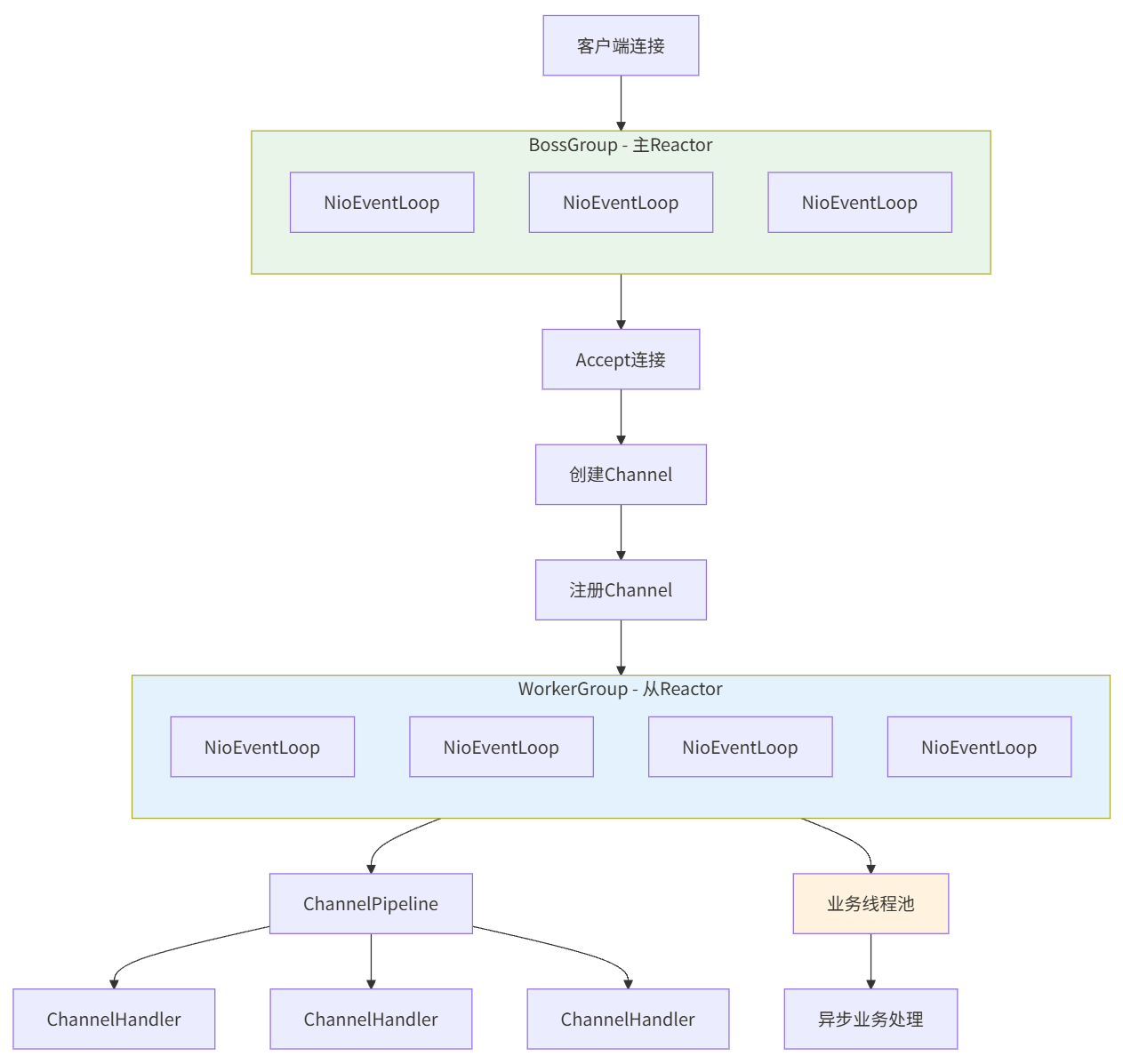Netty网络架构与Reactor模式深度解析
结合响应式编程思想,深入理解Netty的高性能网络编程架构
1. Reactor模式基础
1.1 Reactor核心概念
Reactor模式是一种事件驱动的设计模式,专门用于处理多个客户端并发请求。其核心思想是将请求分发与业务处理分离。
Reactor模式三大核心角色:
| 角色 | 职责 | 对应现实比喻 |
|---|---|---|
| Reactor | 事件监听和分发 | 公司前台总机 |
| Acceptor | 接收新连接 | 接待员 |
| Handler | 处理具体业务 | 各部门专员 |
1.2 Reactor线程模型演进

2.2 Netty核心组件关系
3. Netty核心源码解析
3.1 EventLoop事件循环机制
/*** Netty事件循环核心逻辑*/
public class NioEventLoop extends SingleThreadEventLoop {// 核心选择器,用于监听IO事件private Selector selector;private SelectorProvider provider;@Overrideprotected void run() {for (;;) {try {try {// 1. 计算下一个定时任务的等待时间int strategy = selectStrategy.calculateStrategy(selectNowSupplier, hasTasks());switch (strategy) {case SelectStrategy.CONTINUE:continue;case SelectStrategy.SELECT:// 2. 执行select操作,等待IO事件strategy = selector.select(timeoutMillis);break;default:// fallthrough}// 3. 处理IO事件和任务processSelectedKeys();} finally {// 4. 确保执行所有 scheduled 任务runAllTasks();}} catch (Throwable t) {handleLoopException(t);}}}private void processSelectedKeys() {if (selectedKeys != null) {processSelectedKeysOptimized();} else {processSelectedKeysPlain(selector.selectedKeys());}}private void processSelectedKeysOptimized() {for (int i = 0; i < selectedKeys.size; ++i) {final SelectionKey k = selectedKeys.keys[i];selectedKeys.keys[i] = null;final Object a = k.attachment();//jdk8if (a instanceof AbstractNioChannel) {// 处理Channel的IO事件processSelectedKey(k, (AbstractNioChannel) a);}//jdk17以上if (a instanceof AbstractNioChannel b) {// 处理Channel的IO事件processSelectedKey(k, b);}}}
}
3.2 ChannelPipeline责任链模式
/*** ChannelPipeline实现 - 责任链模式*/
public class DefaultChannelPipeline implements ChannelPipeline {// 责任链的头尾节点final AbstractChannelHandlerContext head;final AbstractChannelHandlerContext tail;@Overridepublic ChannelPipeline addLast(String name, ChannelHandler handler) {return addLast(null, name, handler);}private ChannelPipeline addLast(EventExecutorGroup group, String name, ChannelHandler handler) {final AbstractChannelHandlerContext newCtx;synchronized (this) {// 1. 检查重复性checkMultiplicity(handler);// 2. 创建新的Handler上下文newCtx = newContext(group, filterName(name, handler), handler);// 3. 添加到链表尾部addLast0(newCtx);}// 4. 回调Handler添加事件callHandlerAdded0(newCtx);return this;}private void addLast0(AbstractChannelHandlerContext newCtx) {AbstractChannelHandlerContext prev = tail.prev;newCtx.prev = prev;newCtx.next = tail;prev.next = newCtx;tail.prev = newCtx;}// 事件传播 - 入站事件@Overridepublic ChannelPipeline fireChannelRead(Object msg) {AbstractChannelHandlerContext.invokeChannelRead(head, msg);return this;}// 事件传播 - 出站事件 @Overridepublic ChannelFuture write(Object msg) {return tail.write(msg);}
}/*** Handler上下文 - 维护Handler链表关系*/
abstract class AbstractChannelHandlerContext implements ChannelHandlerContext {volatile AbstractChannelHandlerContext next;volatile AbstractChannelHandlerContext prev;// 入站事件传播static void invokeChannelRead(final AbstractChannelHandlerContext next, Object msg) {final Object m = msg;// 执行下一个Handler的channelRead方法next.invokeChannelRead(m);}private void invokeChannelRead(Object msg) {if (invokeHandler()) {try {// 调用具体Handler的业务逻辑((ChannelInboundHandler) handler()).channelRead(this, msg);} catch (Throwable t) {notifyHandlerException(t);}} else {// 继续传播fireChannelRead(msg);}}
}
4. 响应式编程在Netty中的体现
4.1 异步回调与Future/Promise模式
/*** Future/Promise模式在Netty中的应用*/
public class FuturePromiseExample {public void demonstrateAsync() {Channel channel = ...;// 1. 写入消息并立即返回FutureChannelFuture future = channel.write("Hello World");// 2. 添加监听器,在操作完成时回调future.addListener(new GenericFutureListener<ChannelFuture>() {@Overridepublic void operationComplete(ChannelFuture future) throws Exception {if (future.isSuccess()) {System.out.println("写入成功");} else {System.out.println("写入失败: " + future.cause());}}});// 3. 可以继续执行其他逻辑,无需等待写入完成doOtherWork();}/*** Promise模式 - 手动控制异步操作结果*/public void demonstratePromise() {EventLoop eventLoop = ...;// 创建PromiseDefaultPromise<String> promise = new DefaultPromise<>(eventLoop);// 异步执行任务eventLoop.execute(() -> {try {// 模拟耗时操作Thread.sleep(1000);// 设置成功结果promise.setSuccess("操作完成");} catch (Exception e) {// 设置失败结果promise.setFailure(e);}});// 添加完成监听promise.addListener(future -> {if (future.isSuccess()) {System.out.println("结果: " + future.get());}});}
}
4.2 响应式数据流处理
/*** 基于Netty的响应式数据流处理*/
public class ReactiveStreamHandler extends ChannelInboundHandlerAdapter {// 背压支持private volatile ChannelHandlerContext ctx;private volatile Subscription subscription;@Overridepublic void channelActive(ChannelHandlerContext ctx) {this.ctx = ctx;// 开启读取自动背压ctx.channel().config().setAutoRead(true);}@Overridepublic void channelRead(ChannelHandlerContext ctx, Object msg) {// 响应式处理数据流handleMessageReactive(msg).subscribe(new Subscriber<Object>() {@Overridepublic void onSubscribe(Subscription s) {subscription = s;// 请求第一个数据项s.request(1);}@Overridepublic void onNext(Object processedMsg) {// 处理完成,继续管道传播ctx.fireChannelRead(processedMsg);// 请求下一个数据项subscription.request(1);}@Overridepublic void onError(Throwable t) {ctx.fireExceptionCaught(t);}@Overridepublic void onComplete() {// 流处理完成}});}/*** 响应式消息处理*/private Flowable<Object> handleMessageReactive(Object msg) {return Flowable.just(msg).map(this::decodeMessage).filter(this::validateMessage).flatMap(this::processMessageAsync).onErrorResumeNext(this::handleError);}private Object decodeMessage(Object rawMsg) {// 解码逻辑return rawMsg;}private boolean validateMessage(Object msg) {// 验证逻辑return true;}private Flowable<Object> processMessageAsync(Object msg) {return Flowable.fromFuture(ctx.executor().submit(() -> intensiveProcessing(msg)));}private Flowable<Object> handleError(Throwable error) {// 错误处理逻辑return Flowable.error(error);}private Object intensiveProcessing(Object msg) {// 密集型处理逻辑return msg;}
}
5. Netty完整示例:Echo服务器
/*** 基于Netty的Echo服务器 - 展示完整架构*/
public class NettyEchoServer {public static void main(String[] args) throws Exception {// 1. 创建线程组EventLoopGroup bossGroup = new NioEventLoopGroup(1); // 主ReactorEventLoopGroup workerGroup = new NioEventLoopGroup(); // 从Reactortry {// 2. 创建服务器启动引导ServerBootstrap bootstrap = new ServerBootstrap();bootstrap.group(bossGroup, workerGroup).channel(NioServerSocketChannel.class) // 通道类型.option(ChannelOption.SO_BACKLOG, 100) // 连接队列大小.handler(new LoggingHandler(LogLevel.INFO)) // 主Handler.childHandler(new ChannelInitializer<SocketChannel>() {@Overrideprotected void initChannel(SocketChannel ch) throws Exception {// 3. 配置管道责任链ChannelPipeline pipeline = ch.pipeline();// 添加Handler到责任链pipeline.addLast("decoder", new StringDecoder());pipeline.addLast("encoder", new StringEncoder());pipeline.addLast("business", new EchoServerHandler());pipeline.addLast("exception", new ExceptionHandler());}});// 4. 绑定端口并启动ChannelFuture future = bootstrap.bind(8080).sync();System.out.println("Echo服务器启动在端口 8080");// 5. 等待服务器通道关闭future.channel().closeFuture().sync();} finally {// 6. 优雅关闭bossGroup.shutdownGracefully();workerGroup.shutdownGracefully();}}
}/*** 业务处理器 - 实现Echo逻辑*/
class EchoServerHandler extends ChannelInboundHandlerAdapter {@Overridepublic void channelRead(ChannelHandlerContext ctx, Object msg) {// 响应式处理:接收消息并原样返回String received = (String) msg;System.out.println("服务器收到: " + received);// 异步写回 - 立即返回ChannelFutureChannelFuture future = ctx.writeAndFlush("Echo: " + received + "\n");// 添加完成监听器future.addListener(f -> {if (f.isSuccess()) {System.out.println("消息回显成功");} else {System.out.println("消息回显失败: " + f.cause());}});}@Overridepublic void channelReadComplete(ChannelHandlerContext ctx) {// 读取完成,强制刷新缓冲区ctx.flush();}@Overridepublic void exceptionCaught(ChannelHandlerContext ctx, Throwable cause) {// 异常处理cause.printStackTrace();ctx.close();}
}/*** 异常处理器*/
class ExceptionHandler extends ChannelDuplexHandler {@Overridepublic void exceptionCaught(ChannelHandlerContext ctx, Throwable cause) {System.err.println("处理异常: " + cause.getMessage());ctx.close();}
}
6. 性能优化与最佳实践
6.1 内存管理优化
/*** Netty内存管理最佳实践*/
public class MemoryOptimizationExample {public void demonstrateMemoryManagement() {// 1. 使用池化的ByteBuf分配器ByteBufAllocator allocator = new PooledByteBufAllocator();ByteBuf buffer = allocator.buffer(1024);try {// 2. 写入数据buffer.writeBytes("Hello".getBytes());// 3. 使用retain/release管理引用计数ByteBuf retained = buffer.retain();// 异步处理...processBufferAsync(retained);} finally {// 4. 释放缓冲区if (buffer.refCnt() > 0) {buffer.release();}}}private void processBufferAsync(ByteBuf buffer) {// 在异步处理完成后释放try {// 处理逻辑...} finally {buffer.release();}}/*** 使用CompositeByteBuf减少内存复制*/public void demonstrateCompositeBuffer() {CompositeByteBuf composite = ByteBufAllocator.DEFAULT.compositeBuffer();ByteBuf header = ByteBufAllocator.DEFAULT.buffer();header.writeBytes("Header".getBytes());ByteBuf body = ByteBufAllocator.DEFAULT.buffer();body.writeBytes("Body".getBytes());// 组合缓冲区,避免数据复制composite.addComponents(true, header, body);// 使用组合缓冲区...System.out.println(composite.readableBytes());composite.release();}
}
7. 总结
7.1 Netty架构核心要点
-
Reactor模式实现
- 主从Reactor线程模型
- 事件驱动的异步处理
- 高效的IO多路复用
-
响应式编程思想
- 异步回调机制
- Future/Promise模式
- 背压支持的数据流
-
责任链设计模式
- ChannelPipeline处理器链
- 灵活的业务逻辑组装
- 清晰的责任分离
7.2 性能优势来源
Netty的成功在于它巧妙地将Reactor模式、响应式编程思想和Java NIO技术相结合,构建了一个既高性能又易于使用的网络编程框架。理解这些底层原理对于构建高并发、低延迟的网络应用至关重要。
